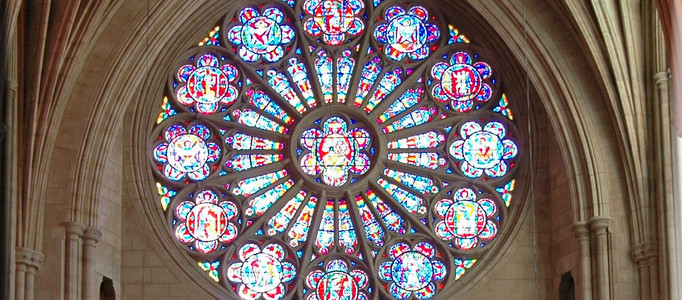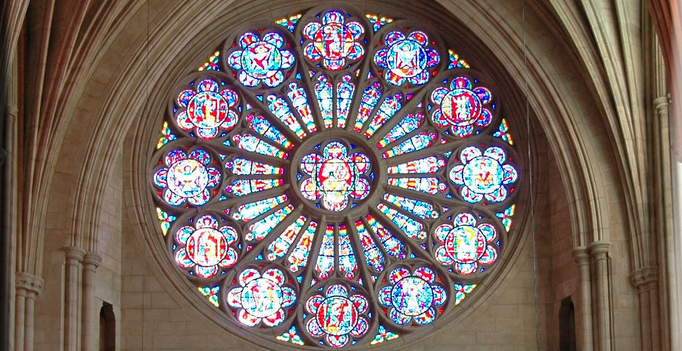 (This series of posts is by an anonymous couple who’ve decided to launch an experiment: a summer of church hopping. Every post will include the perspectives of each in a “she said/he said” format.)
(This series of posts is by an anonymous couple who’ve decided to launch an experiment: a summer of church hopping. Every post will include the perspectives of each in a “she said/he said” format.)
She Said:
I can count on two hands the number of non-LDS church services I’ve been to in my life.
I’ve always felt my lack of experience as just that-a lack. Although I’ve felt curious about other faiths, felt the pull of pealing bells and stained glass, I was always busy with a calling and didn’t want to two-time on my faith. This summer I’m giving myself permission to broaden the scope of my religious understanding.
Where to begin? I have two primary criteria: 1) The church must be LGBTQ friendly, and 2) Women must be able to do everything a man can: preach, read, baptize, bless and pass, etc. Sorry, Catholic Church. I did a bit of research to find a list of LGBTQ-friendly churches in the city where I live, and the list includes the Episcopal Church.
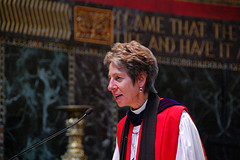 We decide to start with the Episcopal Church partly because we recall an interview on the Colbert Report with the church’s first openly-gay bishop, Gene Robinson. A quick internet search confirms that the local congregation, while undergoing its own schism in 2008 over the issue of Robinson’s ordination, has remained loyal to the larger group and its vote to accept him. As if that weren’t enough, the internet also informs me that the current Presiding Bishop in the U.S. is female: Katharine Jefferts Schori. (Cue angel choirs!)
We decide to start with the Episcopal Church partly because we recall an interview on the Colbert Report with the church’s first openly-gay bishop, Gene Robinson. A quick internet search confirms that the local congregation, while undergoing its own schism in 2008 over the issue of Robinson’s ordination, has remained loyal to the larger group and its vote to accept him. As if that weren’t enough, the internet also informs me that the current Presiding Bishop in the U.S. is female: Katharine Jefferts Schori. (Cue angel choirs!)
Things I love about the service we attended:
- At the back of the church, an usher guides us to a basket of kid’s books and bags to borrow. The bags have a couple of small stuffed animals, clipboards with blank paper, crayons, books, and a sewing card. What the what!? Any self-respecting Mormon woman usually packs her own entertainment bags to church, but this morning, it just so happens I’ve forgotten mine in the dash out the door. I’m super grateful for these, and my kids remain engrossed during the service.

- There are two little girls in white robes, not much older than mine, who are carrying candles down the aisle. Hallelujah! I nudge my girls, rock back on my heels so they have room to watch them hold their candles aloft. I am utterly and completely thrilled to see girls participating in the service. My heart has yearned for this for my daughters.
- While the standing, sitting, and kneeling is a bit disorienting, I find it surprisingly comforting. We’re all doing these motions together, praying words together, acknowledging our sinfulness together (a humbling and cleansing experience). I most definitely feel what I’ve come to understand as the Spirit-warm fuzzies and a lightness of being.
- The music. Check out this beautiful hymn, “Lord of All Hopefulness.”
Things I’m wary of:
- The Nicene Creed. As a Mormon, I’ve been taught my whole life that creeds are Bad with a capital B, one of those things God the Father specifically denounced when he appeared to Joseph in the grove. In the Episcopal service, we actually recite the creed. I may have to read it several more times and assess what I think about it. The whole God-as-three-in-one is a lot to swallow, but I might be able to embrace it in a mystical kind of way.
- I’ll admit as I walked into the church, I am thinking the Episcopal Church must have one of the worst foundational stories of any religion ever, at least as I understand it. King Henry can’t produce an heir with Queen Catherine of Aragon, so he breaks with Catholicism so he can get a divorce and marry his mistress, Anne Boleyn. Then he chops off her head. Divorced, beheaded, died. Divorced, beheaded, survived. And this king was the leader of the Anglican Church, which then became the Episcopal Church in American after the American Revolution. Doesn’t exactly inspire religious devotion, does it? What about that chain of authority going back to Jesus? In all honesty, I don’t think the chain is very important to me anymore, but part of my LDS upbringing gives me pause.
- I have so many questions throughout the service. Do Episcopalians believe in transubstantiation, that the bread and wine actually transform in to the flesh and blood of Christ? Also, in my program, it states everyone who is a baptized Christian is welcome to receive communion. I’m not sure if a Mormon baptism “counts,” so I hold back. I am partly sad to miss out, and partly relieved that I don’t have sip from that goblet everyone is sharing. Ew. Backwash. If I ever do participate, I will be an intinction gal, for sure. Dip that bread in wine and pop in my mouth, thank you!
He Said:
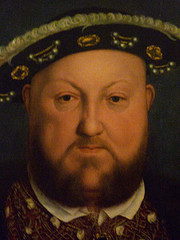 When my wife suggested that we try the Episcopal Church, I immediately started singing “I’m Henry the Eighth, I Am.” In other words, all I could think was, “Isn’t that the church that Henry VIII started so that he could get a divorce?” I had never thought of that as being a very inspiring origin story, but, upon further reflection, it may actually be more positive than it appears. Catholicism had come to define itself in terms of loyalty to the Bishop of Rome (the Pope). The Church of England declared its independence from the corrupt Diocese of Rome, kept some of the best elements of Catholicism, and left the rest. Freedom from the hierarchy seems to have led to some positive changes for the Anglican tradition, such as female ordination, support for civil rights, and acceptance of the LGBTQ community. It makes me wonder what would happen if a (non-polygamous) branch of Mormonism were to declare its independence from Salt Lake. Would it be able to emphasize the good over the true?
When my wife suggested that we try the Episcopal Church, I immediately started singing “I’m Henry the Eighth, I Am.” In other words, all I could think was, “Isn’t that the church that Henry VIII started so that he could get a divorce?” I had never thought of that as being a very inspiring origin story, but, upon further reflection, it may actually be more positive than it appears. Catholicism had come to define itself in terms of loyalty to the Bishop of Rome (the Pope). The Church of England declared its independence from the corrupt Diocese of Rome, kept some of the best elements of Catholicism, and left the rest. Freedom from the hierarchy seems to have led to some positive changes for the Anglican tradition, such as female ordination, support for civil rights, and acceptance of the LGBTQ community. It makes me wonder what would happen if a (non-polygamous) branch of Mormonism were to declare its independence from Salt Lake. Would it be able to emphasize the good over the true?
On the other hand, the Episcopal embrace of change has caused some growing pains, such as the schisms discussed above. The congregation that we attended didn’t come close to filling its large and elegant chapel, and most people there were rather elderly. In order to accommodate shifting tastes, the church offers two separate services, one informal, and one in the High Church tradition. It seemed that the main difference was the choice of musical instruments (guitar in the first, organ in the second). I felt like I saw the real struggle between old and new within each of the services. For example, there was a reading of the story of Abraham being commanded to sacrifice Isaac. 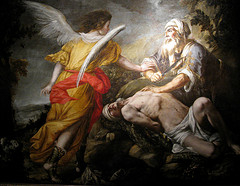 To me, this story exemplifies something very wrong with “true” churches: the idea that blind obedience takes precedence over love or conscience. But the priest’s homily didn’t emphasize that aspect of the story at all. Instead, he talked about the importance of making choices according to our personal goals. It was interesting to hear this fairly liberal understanding of a text that normally demands orthodoxy.
To me, this story exemplifies something very wrong with “true” churches: the idea that blind obedience takes precedence over love or conscience. But the priest’s homily didn’t emphasize that aspect of the story at all. Instead, he talked about the importance of making choices according to our personal goals. It was interesting to hear this fairly liberal understanding of a text that normally demands orthodoxy.
All the pomp and ceremony associated with Catholic and Anglican services can be off-putting for some people, but it is something I have long been fascinated with. I enjoyed the rituals of singing, praying, reciting, and repenting as a group. I was surprised at the reverent attitude brought on by priestly vestments, chanted prayers, and the uplifted cross. It was rather like the temple in a lot of ways, and I found it spiritually edifying.
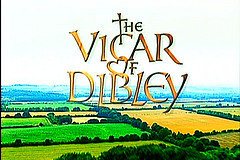 Attending two services is hardly enough to know much about a church, but it was enough to make me want to know more. As a Mormon, I have an ingrained distrust of creeds like the Nicene Creed that Episcopalians recite, but I’m interested in knowing how they understand it. I’d also be curious to talk to an Episcopalian about their definitions of concepts such as scripture and “the church.”
Attending two services is hardly enough to know much about a church, but it was enough to make me want to know more. As a Mormon, I have an ingrained distrust of creeds like the Nicene Creed that Episcopalians recite, but I’m interested in knowing how they understand it. I’d also be curious to talk to an Episcopalian about their definitions of concepts such as scripture and “the church.”
Most importantly, this experience has sparked our interest in a British sitcom called The Vicar of Dibley, which I highly recommend.
